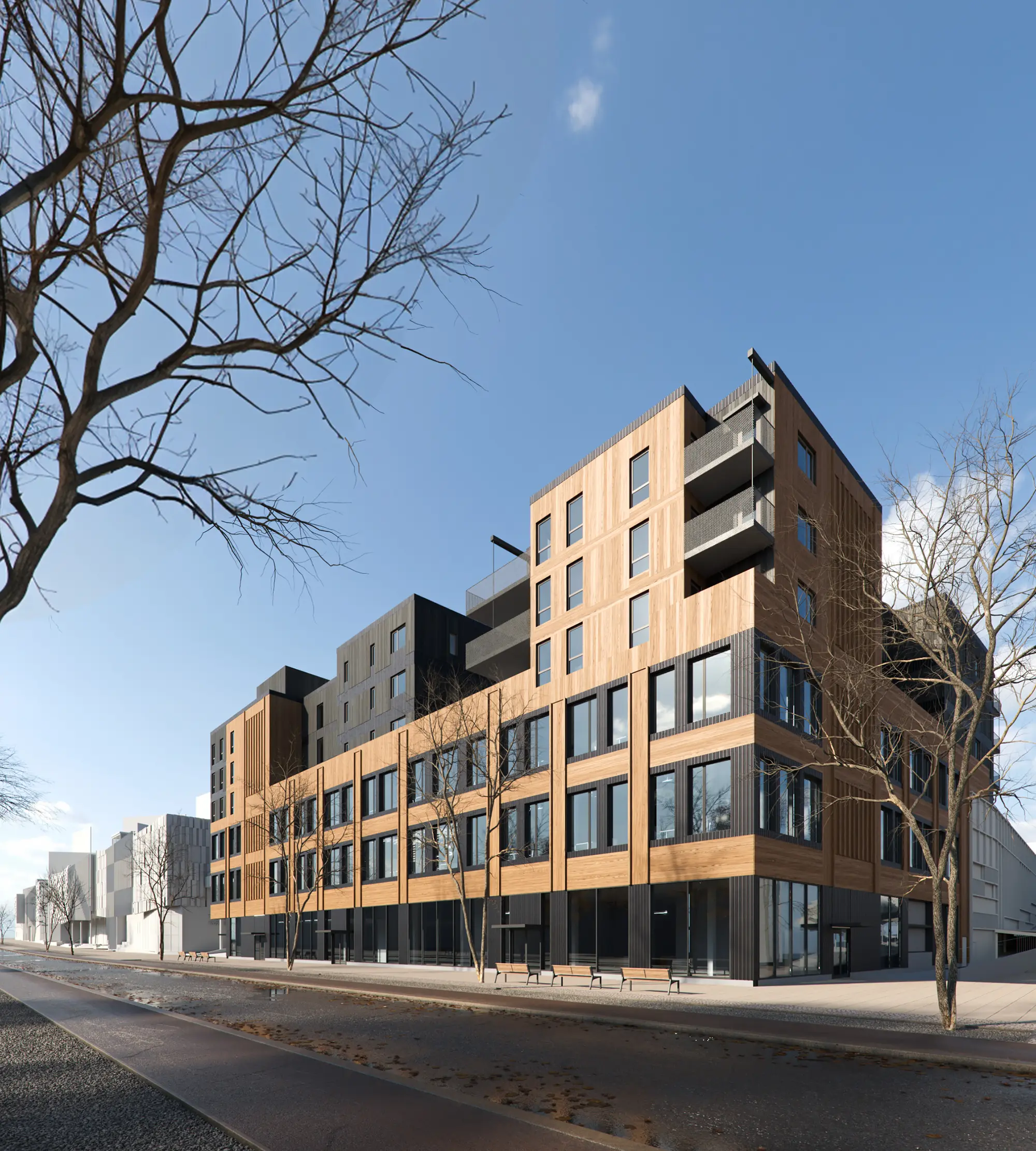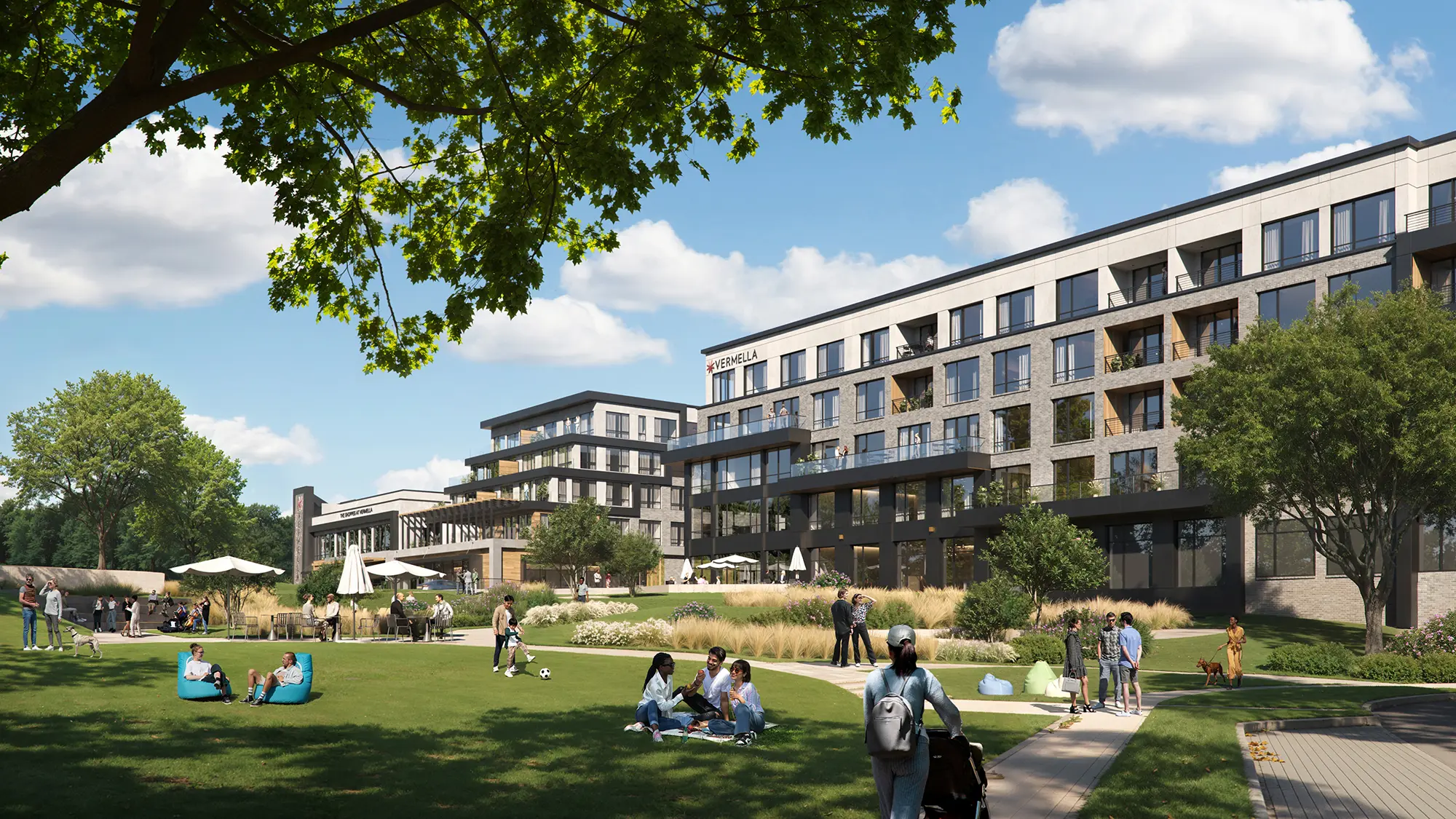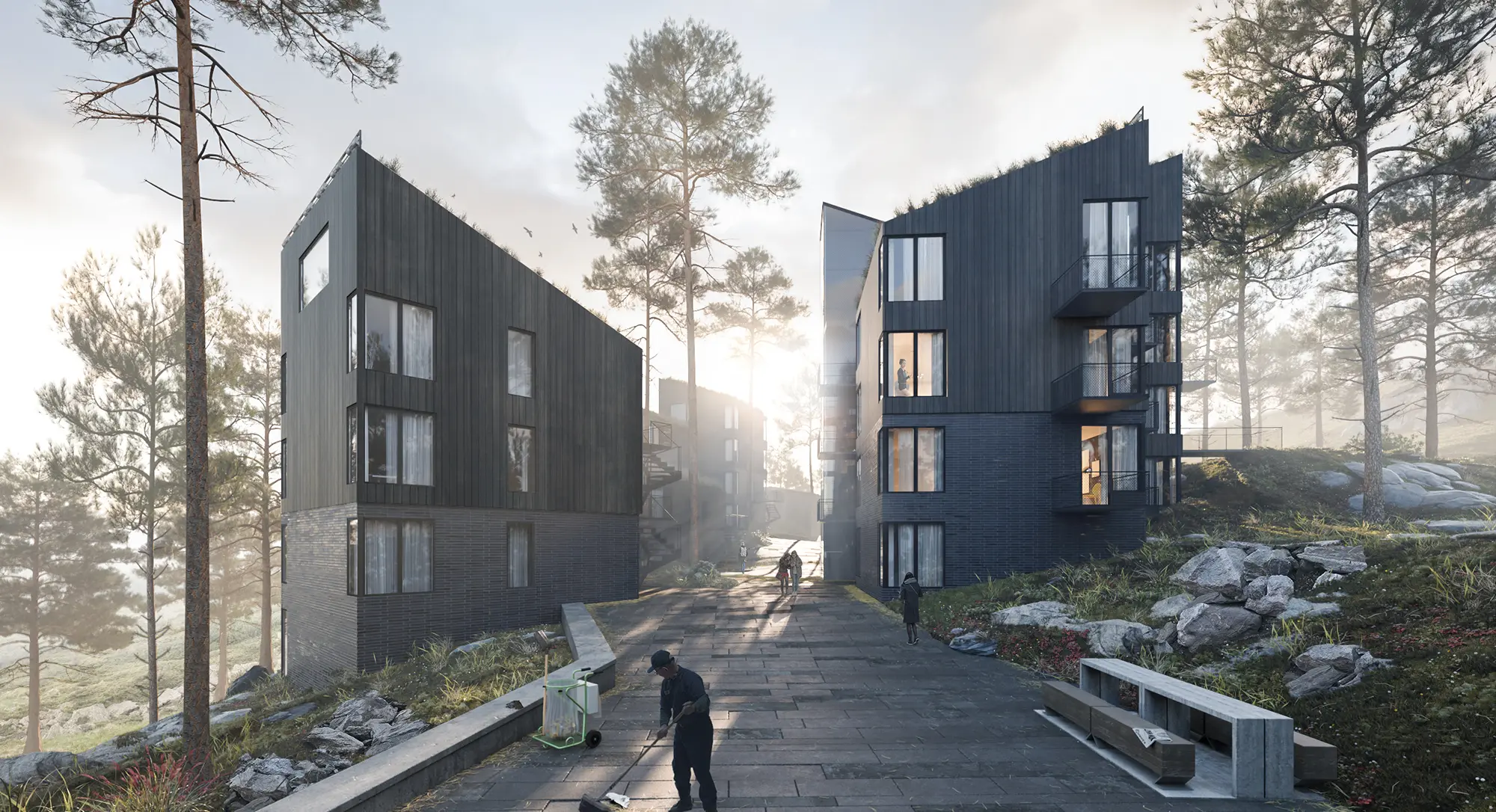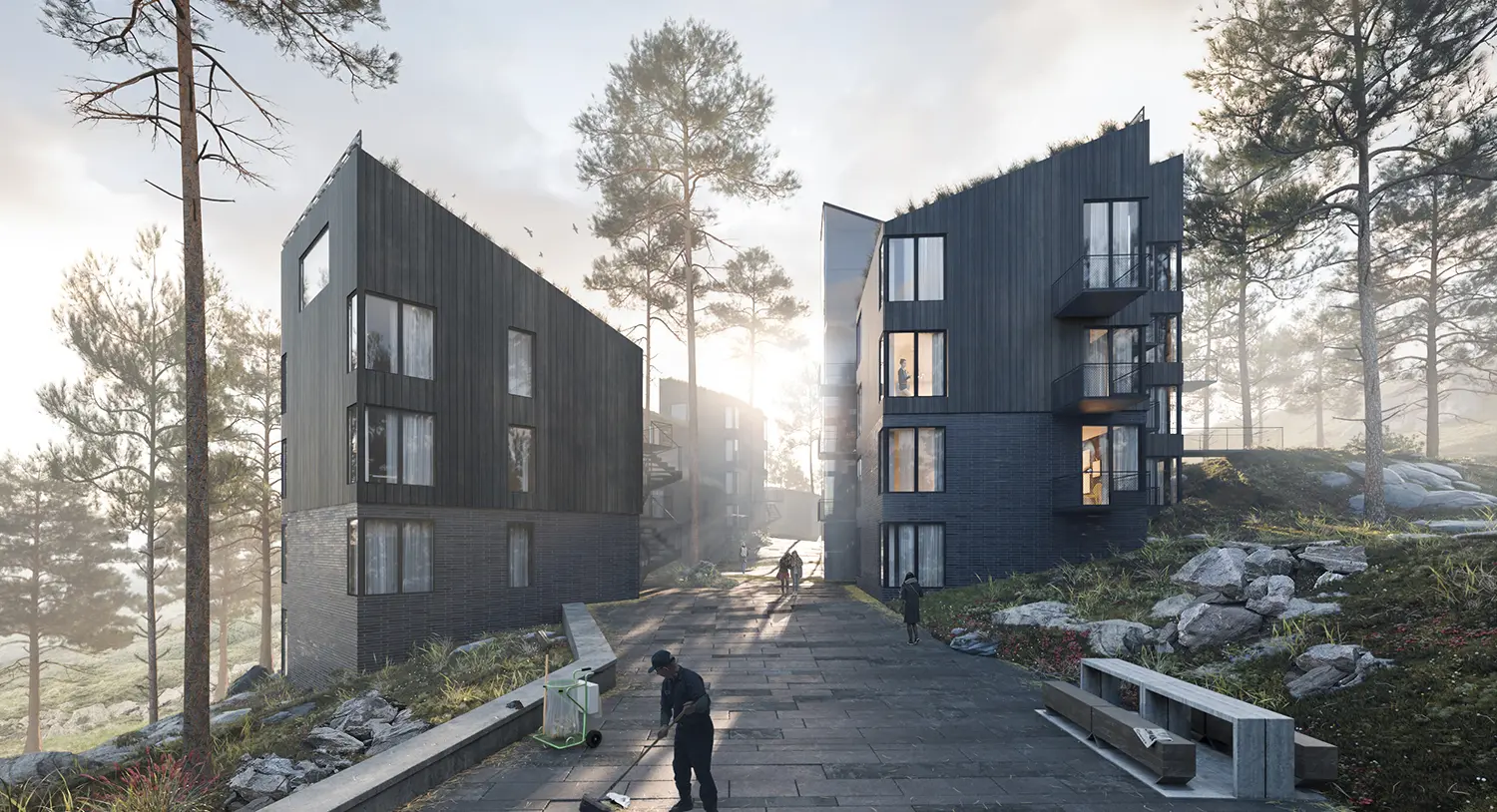It’s no coincidence that 3D visualizers are often called 3D artists. Whether it’s a quick sketch, a stylized presentation, or a photorealistic scene, the choice isn’t mechanical or templated — it’s an authorial approach shaped by the task, context, and project stage.
Studies show that rendering style directly influences how people perceive and engage with architecture. Photorealistic visuals deliver clarity and appeal, while stylized renderings can strengthen recognition and emotional response, particularly in cultural or conceptual contexts.
This clarity of perception directly affects project speed. When stakeholders quickly grasp the design intent, decisions accelerate, revisions decrease, and alignment happens earlier. In this way, the right visualization style becomes a practical tool for efficiency and measurable results. As Zach Jaffe of Landtech Consultants Inc. notes, “Digitalization can reduce project cost and duration by 30–50%, and double returns.”
So, how do you choose the style that fits your goals, audience, and timing? We explain below.
Conceptual Rendering: Communicating the Initial Idea
Renderings at the concept stage don’t require photorealism. A restrained presentation is enough: even tones, clean forms, minimal detail — just enough to convey volume, structure, and spatial logic for architecture firm marketing without visual noise.
Soft and Minimal Rendering Styles for Early-Stage Design
Soft and minimal rendering doesn’t distract with unnecessary detail or give a false impression of completion. It keeps the viewer’s attention on the core — the architectural idea. This approach suits everything from clean section views to expressive stylizations and sketch-style presentations.
Section Views: Exploring Space and Structure
Section views are traditionally seen as part of technical documentation, but within conceptual rendering, they become expressive tools. Stylized sections act like “architectural sketches with depth” — clear, concise, and informative. These visual cuts help capture key spatial and functional connections early on and reveal weaknesses in volume organization before detailed development begins.
Stylized Visuals to Convey Mood and Vision
Like visual sections, stylized renderings operate at the level of architectural expression. Their task is to reflect the mood, character, and emotional direction of the project. Watercolor effects, graphics, pencil textures, or collage techniques convey atmosphere and are especially relevant in early-stage interior development.
The Role of Sketch and Non-Photorealistic Rendering
For architects and designers, non-photorealistic rendering and architectural sketches offer a way to express ideas without the constraints of realism, leaving room for creative exploration. These visualizations retain the expressiveness of hand-drawing while remaining stylistically flexible — easily adaptable to brand, mood, or conceptual intent.

Development Stage Rendering: Defining Materials and Spaces
When an idea becomes a project, the role of visualization is to show how the space will function, what it will look like inside and out, and which materials will be used.
Interior Rendering Styles for Layout and Functionality
Interiors vary — residential or commercial, open or intimate, with different levels of functional load. The visual style is selected based on the nature of the space: sometimes, atmosphere and comfort matter most, sometimes it’s layout accuracy and clear circulation. Interior rendering styles adapt to these tasks, conveying ergonomics, furniture placement, and spatial interaction logic. This uses precise 3D models, realistic materials, and lighting — everything needed to align the 3D visualization closely with future reality.
Visual approaches for different types of spaces can be seen in articles like Mastering 3D Kitchen Rendering, focused on residential kitchen zones, and Living Room 3D Rendering, exploring rendering techniques for living areas.
.webp)
Exterior Visualization Techniques for Building Context
Exterior visualization shows how architecture works within its real environment. Techniques vary by task — from photomatching, inserting models into site photos, to full contextual 3D scenes with surrounding buildings, terrain, greenery, and infrastructure. This helps evaluate scale, rhythm, and material character in context. For developers, such visuals justify design decisions and show that the building is not only effective but also contextually integrated into urban, natural, or mixed surroundings.

Real Estate Rendering: Selling a Vision, Not Just a Space
While architectural exterior renderings show how a building fits its surroundings, real estate visuals emphasize emotional perception. Renderings here act as persuasion tools — not just presenting an object, but selling a lifestyle. Visuals are photorealistic: interiors are carefully crafted in lighting, decor, styling, and even outdoor weather. This creates a sense of presence and emotional engagement. Learn how to highlight a property’s value in 3D Rendering Services for Real Estate, and for the high-end segment, see 3D Architectural Rendering in New York, where rendering has become a strategic sales tool.

High-Fidelity Visualization: From Realism to Hyperrealism
The final render is the audience's touchpoint. It creates interest, sets expectations, and supports project value on the market. At this stage, visualization quality directly shapes the architecture’s perception as a product. Choosing the right approach — from realism to hyperrealistic visual precision — becomes key.
Photorealistic Rendering: Techniques and Tools
Photorealism is a rendering style where architectural space is recreated with photographic accuracy. It conveys not just shape and materials, but light behavior, scene depth, and textural nuance. Advanced rendering engines (V-Ray, Corona, Enscape), physically-based lighting systems (PBR), HDRI environments, and optically accurate materials are used. Post-production also plays a major role, ensuring realistic contrast, color temperature, and depth of field. See Photorealistic Architectural Rendering for more on the subtleties of this approach.

Hyperrealistic Style: Beyond Realism in Detail
Hyperrealistic rendering goes beyond realism, aiming to enhance perception. It emphasizes micro-details: close-up textures, complex lighting scenarios, atmospheric effects, depth of field, and post-production nuances. The result carries a cinematic depth that engages on both visual and emotional levels. In high-end real estate, product presentation, and premium interiors, this approach highlights precision, material richness, and spatial atmosphere. For skyscrapers and high-rise projects, hyperrealistic visualization becomes particularly crucial in showcasing the building's monumental scale and sophisticated facade systems. Check out our tower rendering services for detailed approaches to high-rise visualization. Hyperrealistic rendering becomes a medium of persuasion, evoking confidence in the quality and a tangible sense of aspiration.
Enhanced Visualization Formats: From AI Effects to Immersive Media
As expectations for architectural visuals grow, traditional rendering is now complemented by advanced formats and interactive tools. According to Daniel Sundlin, partner at BIG, architectural storytelling is set to evolve with the rise of sophisticated AI, integrated BIM modeling, and portable immersive technologies like VR and AR. “Soon,” he notes, “we’ll move toward a much more seamless process—where you don’t just walk through models, but interact with them through avatars, using simulation data to test ideas in real time and evaluate their pros and cons collaboratively.”
AI-Driven Style Transfer and Post-Production Effects
AI-style techniques are increasingly used both in early conceptual presentations and in final post-processing. Style transfer and neural effects enable rapid application of visual language, from watercolor and line art to emulating an author’s manner or brand identity. At the concept stage, this helps to set the mood and character efficiently. In final renders, an AI instrument becomes part of advanced post-production, supporting precise color grading, detail enhancement, artistic coherence, and adaptation for portfolios, client presentations, or public releases.
Virtual Reality and 3D Animation for Immersive Presentation
3D animation and virtual reality expand standard architectural presentation by creating a sense of presence, allowing the viewer to move through future spaces and experience scale, light, and flow. For developers and marketers, these tools present architecture as both form and lived experience, capturing atmosphere and emotional resonance.
Furthermore, VR-based presentations could reduce the feedback cycle by up to 40% and boost customer satisfaction.
Rendering Workflow and Software Tools
Effective architectural rendering requires artistic sensitivity and precise technical setup. From software choice to scene organization and render farm use, each decision affects workflow speed, result stability, and visual alignment with project goals. A modern workflow balances quality, performance, and flexible style adaptation across stages and audiences.
A sustainable balance from concept to final render requires a consistent, thoughtful workflow. Below, we review key process aspects — from software choice and scene setup to stylistic consistency in teamwork.
Choosing the Right Rendering Software for Each Style of Rendering
The rendering software choice depends on the required style. For stylization: SketchUp, Twinmotion. For photorealism: V-Ray, Corona, Lumion. For VR: Enscape, Unreal Engine. Each tool is optimized for a specific rendering style architecture. Regional considerations also play a role—different markets may have varying preferences for software ecosystems and visualization standards. Learn more about 3d rendering Australia for insights into how local studios approach software selection and workflow optimization.
From 3D Model to Final Scene: Applying Architectural Rendering Styles Efficiently
Visualization work doesn’t end with 3D modeling; it marks the beginning of scene assembly. A clear structure with proper topology, organized layers, clean UV maps, and optimized geometry provides a reliable foundation for setting up materials and lighting. The architecture rendering styles, whether minimal concept graphics or photorealistic output, should be considered early in the process, including camera angle and color hierarchy.
Balancing Speed, Quality, and Artistic Intent
Thoughtful visualization strikes a balance between artistic goals, technical specifications, and deadlines. Don’t aim for max quality in every frame — instead, match the level of detail to the purpose: concept, working draft, or final marketing render. Understanding which styles and detail levels suit each stage allows for a streamlined process, time-managed and visually accurate.
Best Practices for Collaborative Visualization Using Consistent Rendering Styles
As project scale and team size grow, a unified visual language becomes as critical as managing quality, timelines, and expressiveness. Without it, inconsistencies in style can dilute the architectural narrative, introduce ambiguity in decision-making, and weaken the project's visual identity across presentations, client communications, and marketing materials. Here are the best practices for maintaining a unified style:
- Document the visual style
Create a clear, concise guide with key visualization parameters:
- Color scenarios (day, evening, warm/cool light);
- Material treatment principles (textures, reflections, finishes);
- Standard views and perspective schemes;
- Post-production settings (contrast, saturation, tonal curves).
- Use scene templates and presets
Pre-set scenes and LUTs for post-processing speed up work and reduce visual inconsistency. - Assign a visual coordinator
One expert should oversee adherence to guidelines, moderate iterations, and ensure standardization, especially crucial in distributed teams. - Work on a unified platform
Use collaborative tools like Notion, Trello, Frame.io, or Miro to centralize guides, templates, feedback, and tasks.
If you plan to outsource your visualization work, refer to the recommendations outlined in the article Outsource 3D Architectural Rendering and the list Top 3D Architectural Rendering Companies.
All images © CYLIND

